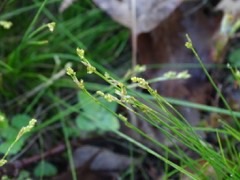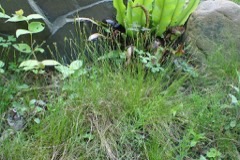 |
|
Reuven Martin inaturalist.org |
 |
| Krzysztof Ziarnek, Kenraiz wikimedia.org |
Translate this page:
Summary
Physical Characteristics

 Carex eburnea is an evergreen Perennial growing to 0.3 m (1ft) by 0.3 m (1ft in) at a slow rate.
Carex eburnea is an evergreen Perennial growing to 0.3 m (1ft) by 0.3 m (1ft in) at a slow rate.
See above for USDA hardiness. It is hardy to UK zone 3. The flowers are pollinated by Wind, Insects.
Suitable for: light (sandy), medium (loamy) and heavy (clay) soils, prefers well-drained soil and can grow in nutritionally poor soil. Suitable pH: mildly acid, neutral and basic (mildly alkaline) soils and can grow in very alkaline soils.
It can grow in full shade (deep woodland) or semi-shade (light woodland). It prefers dry or moist soil and can tolerate drought.
UK Hardiness Map
US Hardiness Map
Synonyms
C. alba Dewey [Illegitimate]. C. alba var. setifolia Dewey. C. setifolia (Dewey) Britton & A.Br. [Illegitimate].
Plant Habitats
Edible Uses
References More on Edible Uses
Medicinal Uses
Plants For A Future can not take any responsibility for any adverse effects from the use of plants. Always seek advice from a professional before using a plant medicinally.
None Known
References More on Medicinal Uses
The Bookshop: Edible Plant Books
Our Latest books on Perennial Plants For Food Forests and Permaculture Gardens in paperback or digital formats.

Edible Tropical Plants
Food Forest Plants for Hotter Conditions: 250+ Plants For Tropical Food Forests & Permaculture Gardens.
More

Edible Temperate Plants
Plants for Your Food Forest: 500 Plants for Temperate Food Forests & Permaculture Gardens.
More

More Books
PFAF have eight books available in paperback and digital formats. Browse the shop for more information.
Shop Now
Other Uses
Ground cover. An attractive first-rate ground cover. Shade and drought tolerant. Good for forest gardens, Rock gardens and shade gardens. An effective accent for smaller gardens. Lawn Alternative.
Special Uses
Food Forest Ground Cover
References More on Other Uses
Cultivation details
A North American native low maintenance sedge. Prefers a sandy or gravelly soil with a neutral to alkaline pH. Prefers a medium moisture, well-drained soil but will tolerate dry conditions. Very tough tolerating heat and drought. It handles dry conditions best when planted in shade. Light: Sun: Part shade to full shade. USDA Hardiness Zone: 2 to 8. Bloom Time: April. Tolerate: Deer, Heavy Shade. Plants spread slowly by rhizomes. In garden design, as well as the above-ground architecture of a plant, root structure considerations help in choosing plants that work together for their optimal soil requirements including nutrients and water. The root pattern is suckering with new plants from runners away from the plant [2-1].
References Carbon Farming Information and Carbon Sequestration Information
Temperature Converter
Type a value in the Celsius field to convert the value to Fahrenheit:
Fahrenheit:
The PFAF Bookshop
Plants For A Future have a number of books available in paperback and digital form. Book titles include Edible Plants, Edible Perennials, Edible Trees,Edible Shrubs, Woodland Gardening, and Temperate Food Forest Plants. Our new book is Food Forest Plants For Hotter Conditions (Tropical and Sub-Tropical).
Shop Now
Plant Propagation
Propagate by seed, or clump division in early spring. Can be cut back regularly during its growing season.
Other Names
If available other names are mentioned here
Ivory sedge,Ebony sedge, Bristleleaf, Bristle-leaved sedge.
Native Range
NORTHERN AMERICA: Canada (Northwest Territories, Yukon), New Brunswick, Newfoundland and Labrador, Nova Scotia, Ontario, Québec, Alberta, British Columbia, Manitoba, Saskatchewan), United States (Alaska, Connecticut, Indiana, Maine, Massachusetts, Michigan, New Hampshire, New Jersey, New York, Ohio, Pennsylvania, Vermont, West Virginia, Illinois, Iowa, Minnesota, Missouri, Nebraska, North Dakota, South Dakota, Wisconsin, Alabama, Arkansas, Kentucky, North Carolina, South Carolina, Tennessee, Virginia), Mexico (San Luis Potosí, Querétaro)
Weed Potential
Right plant wrong place. We are currently updating this section.
Please note that a plant may be invasive in one area but may not in your area so it's worth checking.
None Known
Conservation Status
IUCN Red List of Threatened Plants Status : Not Listed.

Growth: S = slow M = medium F = fast. Soil: L = light (sandy) M = medium H = heavy (clay). pH: A = acid N = neutral B = basic (alkaline). Shade: F = full shade S = semi-shade N = no shade. Moisture: D = dry M = Moist We = wet Wa = water.
Now available:
Food Forest Plants for Mediterranean Conditions
350+ Perennial Plants For Mediterranean and Drier Food Forests and Permaculture Gardens.
[Paperback and eBook]
This is the third in Plants For A Future's series of plant guides for food forests tailored to
specific climate zones. Following volumes on temperate and tropical ecosystems, this book focuses
on species suited to Mediterranean conditions—regions with hot, dry summers and cool, wet winters,
often facing the added challenge of climate change.
Read More
Expert comment
Author
Boott
Botanical References
Links / References
For a list of references used on this page please go here
Readers comment
| Add a comment |
|
If you have important information about this plant that may help other users please add a comment or link below. Only comments or links that are felt to be directly relevant to a plant will be included. If you think a comment/link or information contained on this page is inaccurate or misleading we would welcome your feedback at [email protected]. If you have questions about a plant please use the Forum on this website as we do not have the resources to answer questions ourselves.
* Please note: the comments by website users are not necessarily those held by PFAF and may give misleading or inaccurate information.
To leave a comment please Register or login here All comments need to be approved so will not appear immediately.
|
|